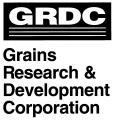You are here: Home > Post-Harvest Integrity > CRC50059: Fumigation Technology
CRC50059: Fumigation Technology
This project investigated options to overcome the cause of deficient fumigation, sustain the life of phosphine and enable the effective application of new fumigants. It will develop an integrated aeration-fumigation technology for faster, more reliable and sustainable grain disinfestation.
Overall it will develop improvements to the fumigation capability of grain storage facilities, fumigation technologies and practices to better control pest insects and keep Australia's grain export industry free from insect strains resistant to phosphine.
Research outcomes:
- Quantification of each of the phenomena involved in applying fumigants in gas-tight industrial grain stores and demonstrated the significance of each via field trials and mathematical modelling (e.g. sorption, silo breathing, leakage, flow dispersion).
- A data set defining the mortality of representative stored product insects to “interrupted” PH3 doses.
- An extensive data set quantifying phosphine, methyl bromide and ethyl formate sorption by grain.
- A mathematical model defining the kinetics of fumigant sorption by grain.
- A data set defining the intergranular gas flow dispersion coefficients of packed beds of grain.
- A computational fluid dynamics model of fan-forced fumigation based on the significant influences identified with field trials, including industrial scale validation of the fundamental mass transport equation set.
- Simulations of recirculated fumigation in silos.
- Field trial data sets describing phosphine distribution for a recirculated fumigation system in gas-tight silos and losses due to weather influences and grain sorption.
- Evidence based diagnosis of the significant mass transport phenomena that determine the distribution of fumigants in stored grain.
- Performance of a commercial industrial scale fan-forced fumigant dispensing system designed for implementation in large scale grain stores, with a focus on aeration-cooled silos (collaborative effort with manufacturer).
- A commercial prototype system combining fan-forced phosphine fumigation with aeration-cooling in large silos (>1000tonne) addresses the problems identified and is being traded by an industry technology supplier (Kotzur).
Research implications:
- The roles of the factors affecting fumigant doses within fan-forced fumigated grain stores (mortality, distribution, sorption, leakage) were diagnosed with laboratory data and modelling and validated with field trials. These results identified the main causes of fumigation failure and resistance selection with this fumigation system.
- The experimentally determined data sets and mathematical models act as ongoing contributions to the science and technology of grain storage and fumigation which are listed here as follows.
- A data set defining the mortality of representative stored product insects to “interrupted” PH3 doses.
- An extensive data set quantifying phosphine, methyl bromide and ethyl formate sorption by grain.
- A mathematical model defining the kinetics of fumigant sorption by grain.
- A data set defining the intergranular gas flow dispersion coefficients of packed beds of grain.
- A computational fluid dynamics model of fan-forced fumigation based on the significant influences identified with field trials, including industrial scale validation of the fundamental mass transport equation set.
- Field trial data sets describing phosphine distribution for a recirculated fumigation system in gas-tight silos and losses due to weather influences and grain sorption.
- Evidence based diagnosis of the significant mass transport phenomena that determine the distribution of fumigants in stored grain.
- A prototype commercial industrial scale fan-forced fumigant dispensing system designed for implementation in large scale grain stores, with a focus on aeration-cooled silos (collaborative effort with manufacturer) was developed and its performance defined.
- The research results of this project in fan-forced fumigated stores illustrate that selection of PH3 resistant strains of insects is predominantly affected by fumigant distribution versus sorption, and the analysis approach of this work should be continued for non fan-forced grain fumigation systems.
Acknowledgements:
The following collaborators are gratefully acknowledged for the contribution to the success of this project.
- Co-operative Bulk Handling of WA; Ernie Kostas, Graeme George, Alan Bone, Aaron Rhodes, Dean Scott, Phil Taylor.
- CSIRO Ecosystem Sciences; Stephen Beckett, Tracy Willis, Tiffany Cripps, Aaron Barrett, Ben Padovan, Julie Cassells
- GrainCorp Operations Pty Ltd; Matthew Head, Robyn Reid, Warren Bremer, Bruce Cole
- Kotzur Engineering; Andrew Kotzur, Murray Collis, Malcom Bruce, Kevin Hunt, John Bickerton
- University of WA; Professor Liang Cheng, Dr Ming Zhao, Wei He, Dr Pat Morgan
- Viterra SA; Greg Hopkins, Steve Buick, Geoff Masters, Merv Crossman, Grant Haines
Publications for this project
PROJECT LEADER
Mr James Darby
Project Leader CRC50059: Fumigation Technology
james.darby@csiro.au
Phone: 02 6246 4197
Fax: 02 6246 4202
Read More
PROJECT DETAILS
Status
Complete
Term
July 2007 – August 2009
Budget
$966,324 (cash and in-kind support)
Complete
Term
July 2007 – August 2009
Budget
$966,324 (cash and in-kind support)






